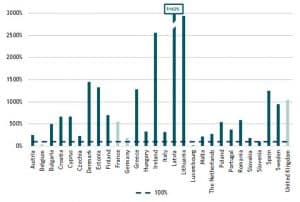Opportunities from the inclusion of hydrogen in NECPs
Ambitious energy and climate policy requires a determined, holistic and coordinated approach and implementation. The National Energy and Climate Plans, NECPs, represent the key mechanism for reporting on future policy between European Union member states and the European Commission in a consistent way. They are used by the commission to monitor EU-wide progress in achieving the 2030 targets and to identify necessary actions. The latest reporting period considered a 10-year timespan between 2021 and 2030. The draft NECPs were submitted by EU countries at the end of 2018 whereas the final version was due by the end of 2019 after a detailed assessment by the commission. In the context of hydrogen all EU member states are encouraged to develop and implement their own strategies to enable hydrogen deployment taking the European framework and guidance into account.
In order to better include hydrogen in future national energy and climate plans and policies the Fuel Cells and Hydrogen Joint Undertaking, FCH JU, in consultation with the European Commission’s department for energy, commissioned a study on the “Opportunities for Hydrogen Energy Technologies considering the National Energy & Climate Plans.” The objective was to identify and evaluate national opportunities for hydrogen deployment and perform an analysis for two hydrogen deployment scenarios based on information in NECPs and other sources. The analysis at the member state level focused on renewable and low-carbon hydrogen until 2030 in the EU’s 27 member states plus the United Kingdom. The results are presented and summarized in individual fiches per member state and a comprehensive main report including methodology, assumptions and member state comparison (see website). The study has been jointly conducted by the consultancies Trinomics and Ludwig-Bölkow-Systemtechnik.
Increasing awareness of hydrogen
In the first step the analysis focuses on the extent to which hydrogen deployment is addressed by the NECPs and provides an overview of the related national targets, policies and initiatives. Nearly all member states mention hydrogen in their NECPs showing that it is broadly recognized as an important element of future energy and climate policy. Moreover, in comparison to the draft version the final NECPs pay much more attention to hydrogen which is gaining momentum in the debate on decarbonizing the EU economy. Due to the reporting structure defined in the EU’s Energy Governance Regulation 2018/1999 the information regarding policies and measures that are directly or indirectly related to hydrogen is scattered across different parts of the respective document.
Hydrogen is mainly considered as a short-term and seasonal flexibility provider as well as a solution for greening fossil fuel use in hard-to-abate applications in industry and transport. The initiatives mentioned in NECPs focus on research, pilot and demonstration projects for hydrogen production, transport/distribution and storage, and end use, in particular for transport purposes. Several NECPs comprise expected or targeted hydrogen demand for 2030, while only a few also include targets for hydrogen production. The intended regulatory measures typically refer to renewable gases which include hydrogen and focus on financial or fiscal improvements that would help to facilitate their development. In most member states, a specific hydrogen association or working group has been established which serves as a useful instrument for exchanging information and initiating and coordinating projects.
Only some NECPs comprise concrete dedicated measures to facilitate hydrogen deployment and its integration into energy systems. The majority of the member states do not address how the national regulatory frameworks will actually be improved and provide limited information regarding measures to effectively address the barriers to hydrogen deployment. However, several NECPs refer to specific hydrogen roadmaps or strategies that have been or will be elaborated at national level. These documents provide more comprehensive approaches, covering the different components of the hydrogen value chain (see H2-international, February 2021).
… Read more in the latest H2-International e-Journal, May 2021
Author: Dr. Jan Michalski, Ludwig-Bölkow-Systemtechnik GmbH (LBST), Ottobrunn

























0 Comments